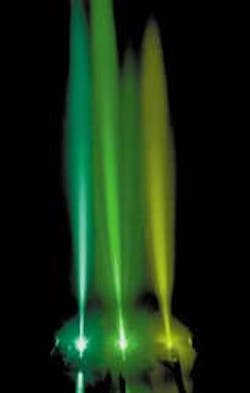
Plastic optical fibers are being examined as an inexpensive alternative to glass fibers for short optical-data transmission lengths. As with any fiber, matching the wavelength of the signal emitter to the transmission characteristics of plastic fiber is important. A typical polymethyl methacrylate plastic fiber reaches its highest transmission at 560 nm—a wavelength outside the range of laser diodes that are indium phosphide-based (614-nm emission and longer) and gallium nitride-based (460-nm emission and shorter). Researchers at the University of Bremen (Bremen, Germany) are developing zinc selenide (ZnSe)-based semiconductor lasers specifically for use with plastic optical fibers.1
The lasers are based on gallium arsenide substrates with magnesium zinc sulfide selenide (MgZnSSe) cladding. Quantum wells with high cadmium (Cd) content and high crystallinity are grown on the cladding using CdZnSSe material. The lasers have cleaved mirrors with no facet coating applied. Electrical pumping of the laser diodes was carried out at duty cycles of 0.01% (pulsed) and 100% (continuous wave). A peak output power of more than 1 W was obtained in the pulsed mode, according to Matthias Klude, one of the researchers. Although output power was not measured in the continuous-wave mode because of the laser's short lifetime of a few minutes, similar but shorter-wavelength lasers made by the group have been measured at 75 mW output. The lasers shown here emit at (from left to right) 505, 528, and 560 nm.
As for the short lifetime, Klude notes that more-advanced construction, including high-reflectivity facet coatings and top-down mounting of the chip, will result in longer-lasting lasers. In addition, the group has fabricated a 560-nm-emitting quantum-dot laser based on CdSe dots, though with a very high threshold. First results from an ongoing experiment indicate that the underlying degradation mechanism in the quantum-dot laser has a different long-term characteristic that results in slower degradation than for the quantum-well structures, said Klude. The researchers will now directly compare the two types of green-emitting devices under the same conditions.
REFERENCE
- M. Klude and D. Hommel, Appl. Phys. Lett. 79(16), 2523 (Oct. 15, 2001).
About the Author
John Wallace
Senior Technical Editor (1998-2022)
John Wallace was with Laser Focus World for nearly 25 years, retiring in late June 2022. He obtained a bachelor's degree in mechanical engineering and physics at Rutgers University and a master's in optical engineering at the University of Rochester. Before becoming an editor, John worked as an engineer at RCA, Exxon, Eastman Kodak, and GCA Corporation.
